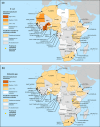Review and analysis of the overlapping threats of carbapenem and polymyxin resistant E. coli and Klebsiella in Africa
- PMID: 37013626
- PMCID: PMC10071777
- DOI: 10.1186/s13756-023-01220-4
Review and analysis of the overlapping threats of carbapenem and polymyxin resistant E. coli and Klebsiella in Africa
Erratum in
-
Correction: Review and analysis of the overlapping threats of carbapenem and polymyxin resistant E. Coli and Klebsiella in Africa.Antimicrob Resist Infect Control. 2024 May 12;13(1):51. doi: 10.1186/s13756-024-01403-7. Antimicrob Resist Infect Control. 2024. PMID: 38735960 Free PMC article. No abstract available.
Abstract
Background: Carbapenem-resistant Enterobacterales are among the most serious antimicrobial resistance (AMR) threats. Emerging resistance to polymyxins raises the specter of untreatable infections. These resistant organisms have spread globally but, as indicated in WHO reports, the surveillance needed to identify and track them is insufficient, particularly in less resourced countries. This study employs comprehensive search strategies with data extraction, meta-analysis and mapping to help address gaps in the understanding of the risks of carbapenem and polymyxin resistance in the nations of Africa.
Methods: Three comprehensive Boolean searches were constructed and utilized to query scientific and medical databases as well as grey literature sources through the end of 2019. Search results were screened to exclude irrelevant results and remaining studies were examined for relevant information regarding carbapenem and/or polymyxin(s) susceptibility and/or resistance amongst E. coli and Klebsiella isolates from humans. Such data and study characteristics were extracted and coded, and the resulting data was analyzed and geographically mapped.
Results: Our analysis yielded 1341 reports documenting carbapenem resistance in 40 of 54 nations. Resistance among E. coli was estimated as high (> 5%) in 3, moderate (1-5%) in 8 and low (< 1%) in 14 nations with at least 100 representative isolates from 2010 to 2019, while present in 9 others with insufficient isolates to support estimates. Carbapenem resistance was generally higher among Klebsiella: high in 10 nations, moderate in 6, low in 6, and present in 11 with insufficient isolates for estimates. While much less information was available concerning polymyxins, we found 341 reports from 33 of 54 nations, documenting resistance in 23. Resistance among E. coli was high in 2 nations, moderate in 1 and low in 6, while present in 10 with insufficient isolates for estimates. Among Klebsiella, resistance was low in 8 nations and present in 8 with insufficient isolates for estimates. The most widespread associated genotypes were, for carbapenems, blaOXA-48, blaNDM-1 and blaOXA-181 and, for polymyxins, mcr-1, mgrB, and phoPQ/pmrAB. Overlapping carbapenem and polymyxin resistance was documented in 23 nations.
Conclusions: While numerous data gaps remain, these data show that significant carbapenem resistance is widespread in Africa and polymyxin resistance is also widely distributed, indicating the need to support robust AMR surveillance, antimicrobial stewardship and infection control in a manner that also addresses broader animal and environmental health dimensions.
© 2023. The Author(s).
Conflict of interest statement
The authors declare that they have no competing interests.
Figures



References
-
- World Health Organization (WHO). Global antimicrobial resistance surveillance system (GLASS) report: early implementation 2020 [Internet]. Geneva, Switzerland; 2020. Available from: https://apps.who.int/iris/bitstream/handle/10665/332081/9789240005587-en...
Publication types
MeSH terms
Substances
LinkOut - more resources
Full Text Sources

